地点介词的用法
七年级上册英语地点介词to,into,onto用法及练习
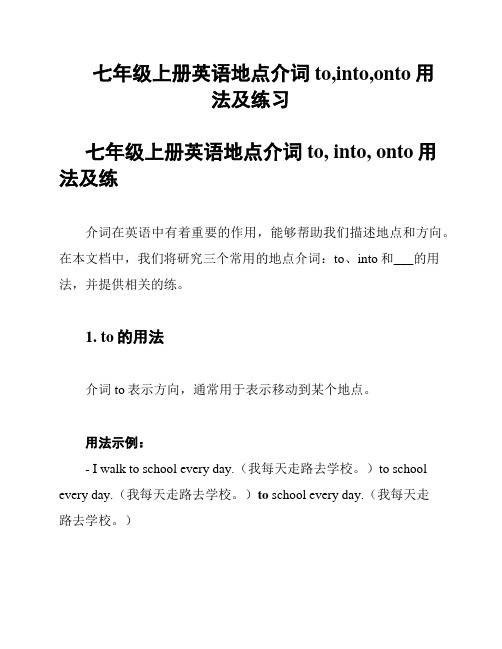
七年级上册英语地点介词to,into,onto用法及练习七年级上册英语地点介词to, into, onto用法及练介词在英语中有着重要的作用,能够帮助我们描述地点和方向。
在本文档中,我们将研究三个常用的地点介词:to、into和___的用法,并提供相关的练。
1. to的用法介词to表示方向,通常用于表示移动到某个地点。
用法示例:- I walk to school every day.(我每天走路去学校。
)to school every day.(我每天走路去学校。
)to school every day.(我每天走路去学校。
)- She goes to the park with her friends.(她和朋友们一起去公园。
)to the park with her friends.(她和朋友们一起去公园。
)to the park with her friends.(她和朋友们一起去公园。
)2. into的用法介词into表示进入某个地点的动作。
用法示例:- The cat jumped into the box.(猫跳进了盒子里。
)into the box.(猫跳进了盒子里。
)into the box.(猫跳进了盒子里。
)- We went into the ___ dinner.(我们进入餐厅吃晚饭。
)into the restaurant to have dinner.(我们进入餐厅吃晚饭。
)into the restaurant to have dinner.(我们进入餐厅吃晚饭。
)3. onto的用法介词onto表示到达某个平面或表面的动作。
用法示例:- The book ___.(书掉到了地板上。
)onto the floor.(书掉到了地板上。
)onto the floor.(书掉到了地板上。
)- ___ the roof of the house.(他爬上了屋顶。
)onto the roof of the house.(他爬上了屋顶。
方位介词用法

二、表示地点的介词 in、on、behind、next to、near、over、under(1). in在……里面: The pencil is in the desk. 铅笔在课桌里。
(2). on在……上面: There are some apple on the tree. 树上有些苹果。
(3). under在……下面/正下方:What's under your desk? 你书桌底下是什么?(4). over在……正上方: There is a shelf over the table. 桌子上方有一个书架。
(5). above 在……斜上方:Raise your arms above your head. (6). below 在……斜下方:Her skirt came below her knees.(7).behind在……之后: There is a bike behind the tree. 树后有一辆自行车。
(8).next to在……旁边:There is a café next to the barber's. 理发店隔壁是一家咖啡馆。
(9).near在……附近:My bed is near the window. 我的床在窗户旁。
(10).by 在……旁:He was sitting by the window .第一组:over, above和on的用法1)over指在…的正上方,表示垂直在上。
如: There is a lamp over the desk.2)above指在上方,属于斜上方。
如Raise your arms above your head.3)on指在上面,表示两物体接触。
如:There is a cup on the table.第二组:under/below的用法:1)under在……下面/正下方:What's under your desk?2)below在……斜下方:Her skirt came below her knees.练习:()1The boat is passing___the bridge. A.through B.below C.under D. across()2Two planes are flying___the city.A.through B.over, C. on,D,below()3We can see a river running to the east____the hill. A.under B.belo w C.over D.on()4Do you see the kite___the building. A.over B.cr oss C.on D.aboveC B B D第三组:in和on表示“在……上”1,门一类——镶嵌在墙里的,用in,字画一类——挂在墙面上的,用on()1He put up a map___the back wall because there was a hole___it.A.on;onB.at;inC.on;inD.on;at()2There is a door___the wall.A.onB.toC.ofD.in()3Any man___eyes______his head can see that he's exactly like a rope.A.with;onB.with;inC.on;withD.in;with2,鸟一类落在树上的,用in;苹果一类长在树上的,用on()1There are some birds singing___the trees.A.inB.onC.atD.from()2There are so many apples___that tr ee.A.in B,on C.at D.from第四组:in/on/to表示“接壤”B A B A BAB在A里——用in A和B相邻(接壤)——用on A和B不相邻(不接壤)——用to()1The United States is____the south of Canada and___the east of Japa n.A.to;inB.on;toC.in;besideD.at;on()2The man stood____the window,watching the boys playing outside.A.inB.byC.withD.to()3Japan lies____the east of China.A.on B/to C.in D.withB B BB第五组:at,in表示“在……”1)at表示较小的地点。
地点介词in on at用法
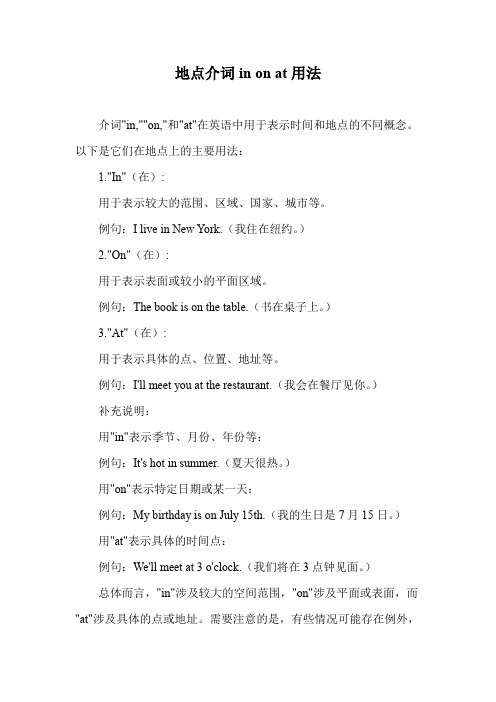
地点介词in on at用法
介词"in,""on,"和"at"在英语中用于表示时间和地点的不同概念。
以下是它们在地点上的主要用法:
1."In"(在):
用于表示较大的范围、区域、国家、城市等。
例句:I live in New York.(我住在纽约。
)
2."On"(在):
用于表示表面或较小的平面区域。
例句:The book is on the table.(书在桌子上。
)
3."At"(在):
用于表示具体的点、位置、地址等。
例句:I'll meet you at the restaurant.(我会在餐厅见你。
)
补充说明:
用"in"表示季节、月份、年份等:
例句:It's hot in summer.(夏天很热。
)
用"on"表示特定日期或某一天:
例句:My birthday is on July 15th.(我的生日是7月15日。
)
用"at"表示具体的时间点:
例句:We'll meet at 3 o'clock.(我们将在3点钟见面。
)
总体而言,"in"涉及较大的空间范围,"on"涉及平面或表面,而"at"涉及具体的点或地址。
需要注意的是,有些情况可能存在例外,
因此在具体语境中仍需谨慎使用。
地点介词用法详解和短语辨析

地点介词用法详解和短语辨析
表示地点的英语介词,我们其实学过很多,也掌握过很多种用法。
以下是店铺给大家带来地点介词用法详解,以供参阅。
地点介词用法1
1.in, on, to
(1)in+较大地点;at+较小地点。
When did you arrive in Shanghai? 你是什么时候到上海的?
(2)包含在整体内部的用in,接壤用on,不相邻用to。
①Shandong is in the east of China.
山东在中国的东部。
②Jiangxi is on the east of Hunan.
江西在湖南的东部。
③Japan is to the east of China.
日本在中国的东部。
地点介词用法2
2. “上下”介词on/above/over/below/under
(1)on“在……上面”,表示两者接触。
(2)above“在……的上方”,表示两者不接触,其反义词为below“在……的下方”。
(3)over“在……正上方”,表示两者不接触,其反义词为under“在……正下方”。
地点介词用法3
3."穿越"介词
across (从物体表面)跨越, 越过
through (从物体中间)穿透, 穿越
over(从物体上面)跃过。
表地点的介词atonin的用法

表地点的介词at、on、in到底怎么用【at、on、in的用法】一、at1、用在表示地域面积不大的某个点的地方(如饭桌旁、电影院、车站、机场等)前(to refer to a position or location which we see as a point)I was sitting at my desk、(当时我正坐在课桌旁。
)2、用在公司名称(侧重表达的就是工作的单位,而不就是工作地点)前(to talk about locations at compa nies, workplaces when we see them as a place of activity)How many people are working at Microsoft? (有多人在微软工作?)3、用在很多人参与的活动场合前(to refer to activities which involve a group of people)Were you at Lisa’s party/the cinema/the theatre? (您当时在丽莎的聚会上/电影院里/剧院里不?)4、用在学校前(with school/college/university)She always did well at school、(她在学校表现一直很好。
)5、用在具体地址、某人家里前(to refer to an address or someone's house)They once lived at number 12 South George’s Street、(她们曾经住在南乔治街12号。
)6、用在公共服务场所(to talk about public places where we get treatments, such as a hairdres ser’s or doctor’s surgery)I can’t meet at four、I’ll be at the hairdresser’s until five、(四点我无法跟您碰面。
七年级上册英语地点介词at,in,on用法及练习

七年级上册英语地点介词at,in,on用法及练习七年级上册英语地点介词at,in,on用法及练地点介词是英语语法中的一部分,用于描述人或事物的位置。
在这篇文档中,我们将讨论七年级上册英语中常见的地点介词:at,in和on的用法。
同时,我们也将提供一些练题来帮助你巩固所学内容。
1. at的用法- 用于表示具体的位置或地点,例如:- at school (在学校)- at the park (在公园)- at the bus stop (在公交车站)- 用于表示具体的时间点,例如:- at 9 o'clock (在九点)- at lunchtime (在午餐时间)- at night (在晚上)2. in的用法- 用于表示大的地点范围,例如:- in Beijing (在北京)- in the park (在公园)- in the classroom (在教室)- 用于表示季节、月份、年代等时间段,例如:- in summer (在夏季)- in October (在十月)- in the 1990s (在上世纪九十年代)3. on的用法- 用于表示具体的表面或平面,例如:- on the desk (在桌子上)- on the wall (在墙上)- on the floor (在地板上)- 用于表示具体的日期或星期几,例如:- on Monday (在星期一)- on June 1st (在六月一日)- on New Year's Day (在元旦)练题:填入适当的地点介词(at, in, on)来完成下列句子:1. I will meet you ___ the library.2. The cat is ___ the table.3. We have a class ___ 9 o'clock.4. They are playing soccer ___ the park.5. The party is ___ Friday night.答案:1. at2. on3. at4. in5. on希望本文对你理解七年级上册英语地点介词的用法有所帮助。
地点介词on in at的区别
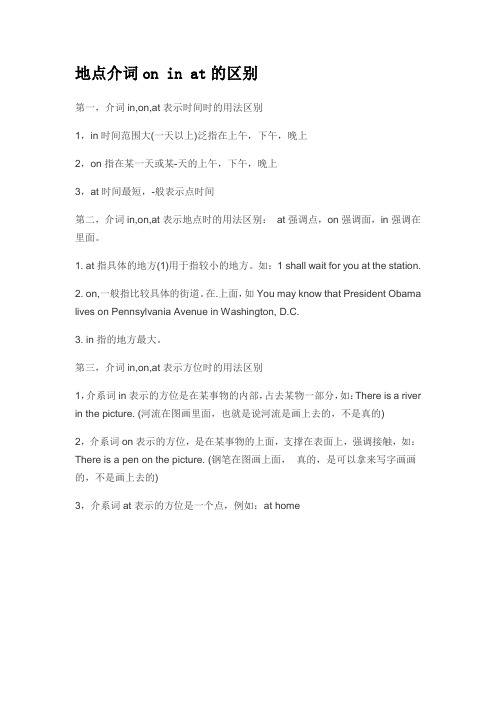
地点介词on in at的区别
第一,介词in,on,at表示时间时的用法区别
1,in时间范围大(一天以上)泛指在上午,下午,晚上
2,on指在某一天或某-天的上午,下午,晚上
3,at时间最短,-般表示点时间
第二,介词in,on,at表示地点时的用法区别:at强调点,on强调面,in强调在里面。
1. at指具体的地方(1)用于指较小的地方。
如:1 shall wait for you at the station.
2. on,一般指比较具体的街道。
在.上面,如You may know that President Obama lives on Pennsylvania Avenue in Washington, D.C.
3. in指的地方最大。
第三,介词in,on,at表示方位时的用法区别
1,介系词in表示的方位是在某事物的内部,占去某物一部分,如:There is a river in the picture. (河流在图画里面,也就是说河流是画上去的,不是真的)
2,介系词on表示的方位,是在某事物的上面,支撑在表面上,强调接触,如:There is a pen on the picture. (钢笔在图画上面,真的,是可以拿来写字画画的,不是画上去的)
3,介系词at表示的方位是一个点,例如:at home。
快速掌握地点介词In、on、at的方法

快速掌握地点介词In、on、at的方法快速掌握地点介词 In、On、At 的方法在英语中,地点介词是用来描述事物或人所在位置关系的词汇。
本文将为您详细介绍如何快速掌握这三个常用的地点介词:in、on、at。
一、介词 In 的用法1. 表示在某个范围内- I live in Beijing. (我住在北京。
)- There is a book in the bag. (书包里有一本书。
)2. 表示在某物体内部- There is water in the bottle. (瓶子里有水。
)- She is in the room. (她在房间里。
)二、介词 On 的用法1. 表示在某物体的表面上- There is a book on the table. (桌子上有一本书。
)- He put the cake on the plate. (他把蛋糕放在盘子上。
)2. 表示在某物体上部- There is a cat on the roof. (屋顶上有一只猫。
)三、介词 At 的用法1. 表示在某个特定点上- I will meet you at the airport. (我在机场等你。
)- She lives at No. 10 Downing Street. (她住在唐宁街10号。
)2. 表示时间点- I will call you at 8 o'clock. (我在8点给你打电话。
)总结通过以上详细解析,我们可以总结出:- In用于表示在某范围内或某物体内部。
- On用于表示在某物体的表面或上部。
- At用于表示某个特定点或时间点。
希望这份文档能帮助您快速掌握这三个地点介词的用法。
在日常英语交流中,灵活运用这些介词,能够更准确地描述事物或人的位置关系。
表地点的介词at、on、in的用法
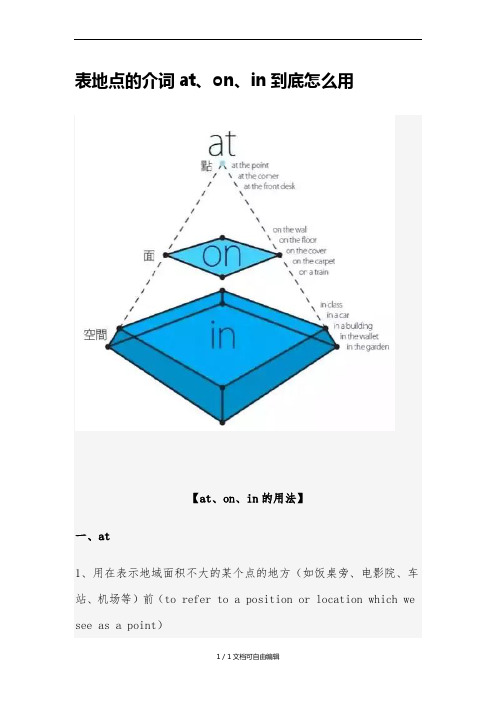
表地点的介词at、on、in到底怎么用【at、on、in的用法】一、at1、用在表示地域面积不大的某个点的地方(如饭桌旁、电影院、车站、机场等)前(to refer to a position or location which we see as a point)I was sitting at my desk. (当时我正坐在课桌旁。
)2、用在公司名称(侧重表达的是工作的单位,而不是工作地点)前(to talk about locations at companies, workplaces when we see them as a place of activity)How many people are working at Microsoft? (有多人在微软工作?)3、用在很多人参与的活动场合前(to refer to activities which involve a group of people)Were you at Lisa’s party/the cinema/the theatre? (你当时在丽莎的聚会上/电影院里/剧院里吗?)4、用在学校前(with school/college/university)She always did well at school. (她在学校表现一直很好。
) 5、用在具体地址、某人家里前(to refer to an address or some one's house)They once lived at number 12 South George’s Street. (他们曾经住在南乔治街12号。
)6、用在公共服务场所(to talk about public places where we g et treatments, such as a hairdresser’s or doctor’s surger y)I can’t meet at four. I’ll be at the hairdresser’s unt il five. (四点我无法跟你碰面。
五个介词的用法
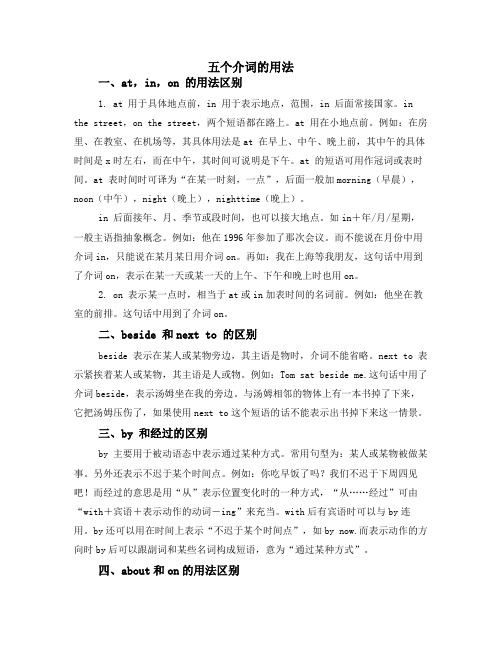
五个介词的用法一、at,in,on 的用法区别1. at 用于具体地点前,in 用于表示地点,范围,in 后面常接国家。
in the street,on the street,两个短语都在路上。
at 用在小地点前。
例如:在房里、在教室、在机场等,其具体用法是at 在早上、中午、晚上前,其中午的具体时间是x时左右,而在中午,其时间可说明是下午。
at 的短语可用作冠词或表时间。
at 表时间时可译为“在某一时刻,一点”,后面一般加morning(早晨),noon(中午),night(晚上),nighttime(晚上)。
in 后面接年、月、季节或段时间,也可以接大地点。
如in+年/月/星期,一般主语指抽象概念。
例如:他在1996年参加了那次会议。
而不能说在月份中用介词in,只能说在某月某日用介词on。
再如:我在上海等我朋友,这句话中用到了介词on,表示在某一天或某一天的上午、下午和晚上时也用on。
2. on 表示某一点时,相当于at或in加表时间的名词前。
例如:他坐在教室的前排。
这句话中用到了介词on。
二、beside 和next to 的区别beside 表示在某人或某物旁边,其主语是物时,介词不能省略。
next to 表示紧挨着某人或某物,其主语是人或物。
例如:Tom sat beside me.这句话中用了介词beside,表示汤姆坐在我的旁边。
与汤姆相邻的物体上有一本书掉了下来,它把汤姆压伤了,如果使用next to这个短语的话不能表示出书掉下来这一情景。
三、by 和经过的区别by 主要用于被动语态中表示通过某种方式。
常用句型为:某人或某物被做某事。
另外还表示不迟于某个时间点。
例如:你吃早饭了吗?我们不迟于下周四见吧!而经过的意思是用“从”表示位置变化时的一种方式,“从……经过”可由“with+宾语+表示动作的动词-ing”来充当。
with后有宾语时可以与by连用。
by还可以用在时间上表示“不迟于某个时间点”,如by now.而表示动作的方向时by后可以跟副词和某些名词构成短语,意为“通过某种方式”。
地点介词的用法总结
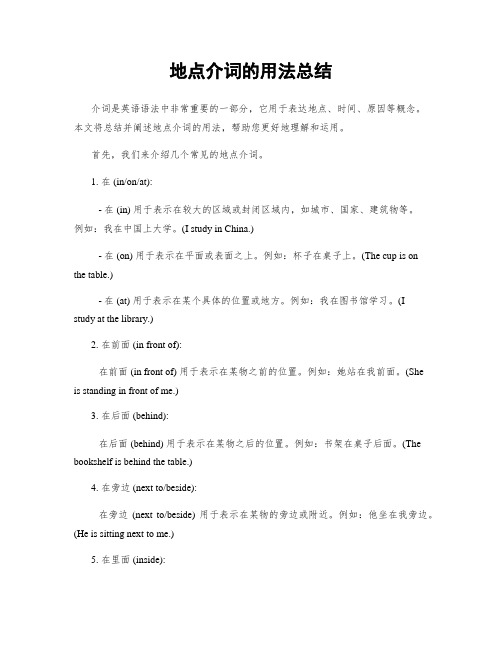
地点介词的用法总结介词是英语语法中非常重要的一部分,它用于表达地点、时间、原因等概念。
本文将总结并阐述地点介词的用法,帮助您更好地理解和运用。
首先,我们来介绍几个常见的地点介词。
1. 在 (in/on/at):- 在 (in) 用于表示在较大的区域或封闭区域内,如城市、国家、建筑物等。
例如:我在中国上大学。
(I study in China.)- 在 (on) 用于表示在平面或表面之上。
例如:杯子在桌子上。
(The cup is on the table.)- 在 (at) 用于表示在某个具体的位置或地方。
例如:我在图书馆学习。
(Istudy at the library.)2. 在前面 (in front of):在前面 (in front of) 用于表示在某物之前的位置。
例如:她站在我前面。
(Sheis standing in front of me.)3. 在后面 (behind):在后面 (behind) 用于表示在某物之后的位置。
例如:书架在桌子后面。
(The bookshelf is behind the table.)4. 在旁边 (next to/beside):在旁边(next to/beside) 用于表示在某物的旁边或附近。
例如:他坐在我旁边。
(He is sitting next to me.)5. 在里面 (inside):在里面 (inside) 用于表示在某物的内部。
例如:猫睡在篮子里面。
(The cat is sleeping inside the basket.)除了以上的常见介词外,还有一些特殊的地点介词:1. 在上面 (above/on top of):在上面 (above/on top of) 用于表示在某物的顶部或上方位置。
例如:鸟飞在树上面。
(The bird is flying above the tree.)2. 在下面 (below/underneath/under):在下面 (below/underneath/under) 用于表示在某物的底部或下方位置。
英语地点介词的正确使用方法
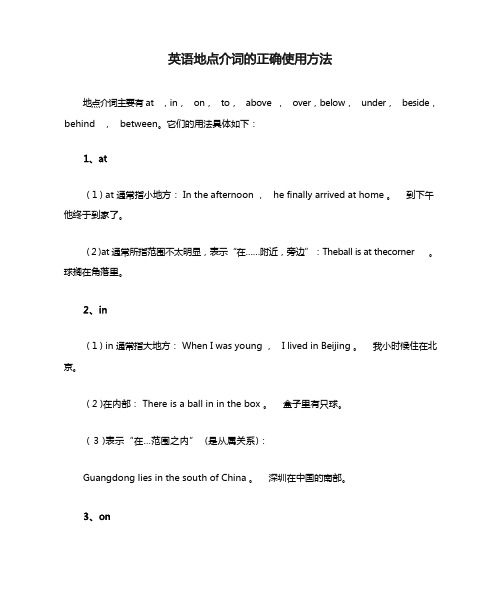
地点介词主要有 at ,in, on, to, above , over,below, under, beside,behind , between。
它们的用法具体如下:( 1 ) at 通常指小地方: In the afternoon , he finally arrived at home 。
到下午他终于到家了。
( 2 )at 通常所指范围不太明显,表示“在……附近,旁边”:Theball is at thecorner 。
球搁在角落里。
( 1 ) in 通常指大地方: When I was young , I lived in Beijing 。
我小时候住在北京。
( 2 )在内部: There is a ball in in the box 。
盒子里有只球。
( 3 )表示“在…范围之内” (是从属关系):Guangdong lies in the south of China 。
深圳在中国的南部。
( 1 ) on 主要指“在……之上”,强调和表面接触:There is a book on the table 。
桌上有一本书。
( 2 )表示毗邻,接壤(是相邻关系) :Canada lies on the north of America 加拿大在美国的北边(与美国接壤)。
主要表示“在……范围外”,强调不接壤,不相邻。
Japan is to the east of China 。
日本在中国的东面。
注意:( 1 ) at 强调“点”,on 强调“面”,in 强调“在里面”,to 表示“范围外”。
( 2 ) on the tree :表示树上本身所长着的叶子、花、果实等in the tree :表示某物或某人在树上on the wall:表示在墙的表面,如图画、黑板等in the wall :表示在墙的内部中,如门窗、钉子、洞、孔在……上方(并未强调是不是正上方) ,与 below 相对。
如:I live in a flat above the shop 。
地点介词的用法

• 地点介词的概述 • 常见地点介词的用法 • 地点介词的特殊用法 • 地点介词的常见错误与纠正方法 • 地点介词的实际应用
01
地点介词的概述
定义与特点
定义
地点介词是用来表示事物位置关 系的介词,通常用于描述事物存 在的位置或方向。
特点
地点介词通常与名词、代词或句 子一起使用,以明确地表达事物 与地点之间的关系。
02
详细描述
at通常用于表示具体地点或位置,如 “at the airport”(在机场)、“at the train station”(在火车站)。而 in则用于表示较大的空间或抽象概念, 如“in the room”(在房间里)、 “in the city”(在城市里)。
03
纠正方法
在选择介词时,要明确所描述的地点 是具体的还是抽象的,以及大小关系 。
the museum.
04
before:表示某物在另一物的前面,强调时间上的先 后顺序。如:I will finish my work before dinner.
behind与at the back of的区别
总结词:两者都表示空间上的位置关 系,但具体含义有所不同。
详细描述
behind:表示某物在另一物的后面, 强调方向上的位置关系。如:The car is behind the building.
描述动作发生地点
在描述动作发生的地点时,地点介词用于连接动词和名词 ,如“我在学校里学习”和“他们在电影院里看电影”。
在学术写作中的应用
描述实验设置
在科学实验或研究中,地点介词用于描述实验设备、材料和样本的位置,如“将试管放在 架子上”和“把样本放入冰箱里”。
介词at和in,on地点用法
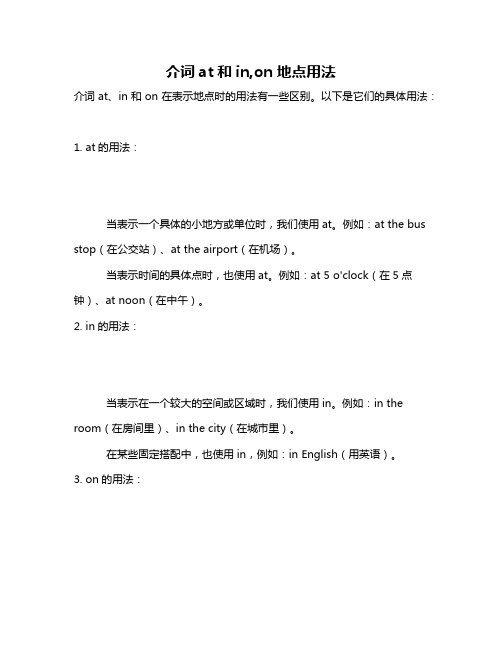
介词at和in,on地点用法
介词at、in和on在表示地点时的用法有一些区别。
以下是它们的具体用法:1. at的用法:
当表示一个具体的小地方或单位时,我们使用at。
例如:at the bus stop(在公交站)、at the airport(在机场)。
当表示时间的具体点时,也使用at。
例如:at 5 o'clock(在5点钟)、at noon(在中午)。
2. in的用法:
当表示在一个较大的空间或区域时,我们使用in。
例如:in the room(在房间里)、in the city(在城市里)。
在某些固定搭配中,也使用in,例如:in English(用英语)。
3. on的用法:
当表示在一个物体的表面或上面时,我们使用on。
例如:on the table(在桌子上)、on the wall(在墙上)。
在表示地理位置时,有时也使用on,例如:on the other side of the river(在河的另一边)。
总的来说,at通常用于表示具体的小地方或时间点,in用于较大的空间或区域,而on用于物体的表面或上面。
不过这些介词的使用有时也会根据习惯和语境有所不同,因此在实际使用中需要根据具体情况进行判断。
地点介词in on at的用法口诀
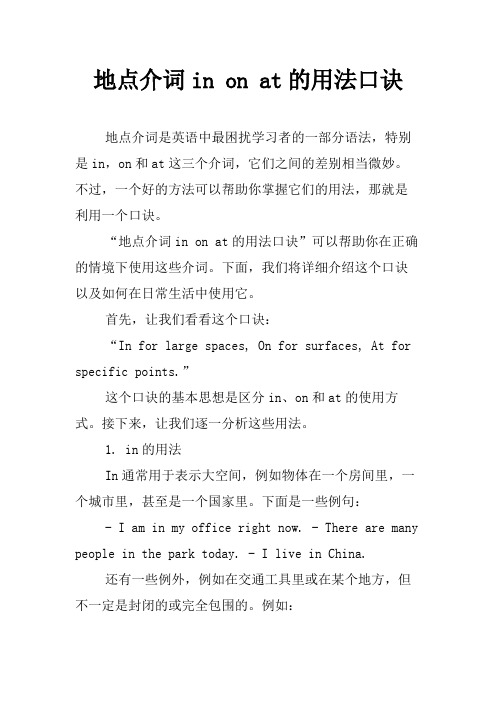
地点介词in on at的用法口诀地点介词是英语中最困扰学习者的一部分语法,特别是in,on和at这三个介词,它们之间的差别相当微妙。
不过,一个好的方法可以帮助你掌握它们的用法,那就是利用一个口诀。
“地点介词in on at的用法口诀”可以帮助你在正确的情境下使用这些介词。
下面,我们将详细介绍这个口诀以及如何在日常生活中使用它。
首先,让我们看看这个口诀:“In for large spaces, On for surfaces, At for specific points.”这个口诀的基本思想是区分in、on和at的使用方式。
接下来,让我们逐一分析这些用法。
1. in的用法In通常用于表示大空间,例如物体在一个房间里,一个城市里,甚至是一个国家里。
下面是一些例句:- I am in my office right now. - There are many people in the park today. - I live in China.还有一些例外,例如在交通工具里或在某个地方,但不一定是封闭的或完全包围的。
例如:- I am in the car on my way to work. - I am in the library studying.2. on的用法On通常用于表示一个平面表面,例如桌子、地图或电视。
下面是一些例句:- The book is on the desk. - The pen is on the paper. - The picture is on the wall.同时,它也可以用于表示某个特定的日期或时间:- My birthday is on December 17th. - I will meet you on Friday at 8pm.3. at的用法At通常用于表示一个具体的、固定的点或位置。
例如:- We will meet at the restaurant. - He is waiting at the bus stop. - She is studying at university.它还可以表示在某个特定的时间或情境下:- I will meet you at 4pm. - I am good at speaking English.值得注意的是,在某些情境下,这三个介词是互相替代的。
表地点的介词at、on、in的用法
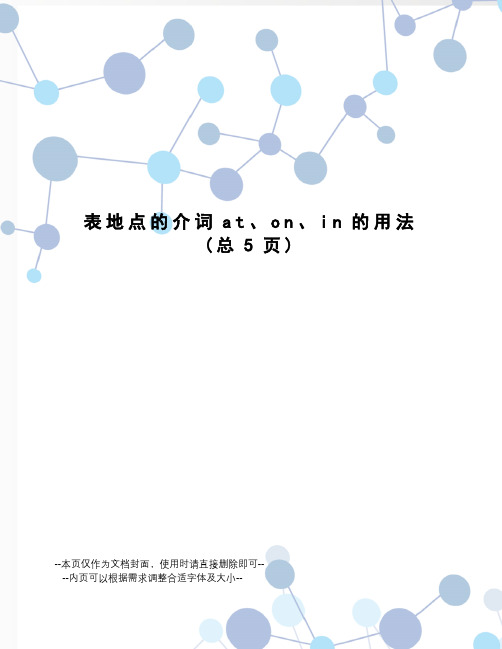
表地点的介词a t、o n、i n的用法(总5页)--本页仅作为文档封面,使用时请直接删除即可----内页可以根据需求调整合适字体及大小--表地点的介词at、on、in到底怎么用【at、on、in的用法】一、at1、用在表示地域面积不大的某个点的地方(如饭桌旁、电影院、车站、机场等)前(to refer to a position or location which we see as a point)I was sitting?at?my desk. (当时我正坐在课桌旁。
)2、用在公司名称(侧重表达的是工作的单位,而不是工作地点)前(to talk about locations at companies, workplaces when we see them as a place of activity)How many people are working?at?Microsoft (有多人在微软工作)3、用在很多人参与的活动场合前(to refer to activities which involve a group of people)Were you?at?Lisa’s party/the cinema/the theatre (你当时在丽莎的聚会上/电影院里/剧院里吗)4、用在学校前(with school/college/university)She always did well?at?school. (她在学校表现一直很好。
)5、用在具体地址、某人家里前(to refer to an address or someone's house)They once lived?at?number 12 South George’s Street. (他们曾经住在南乔治街12号。
)6、用在公共服务场所(to talk about public places where we get treatments, such as a hairdresser’s or docto r’s surgery)I can’t meet at four. I’ll be?at?the hairdresser’s until five. (四点我无法跟你碰面。
地点前的介词用法

地点前的介词用法地点前的介词用法如下:1. "in" 用于大多数国家、城市、地区、建筑物等大的地理位置,例如:- I live in New York.- He works in a hospital.2. "at" 用于具体场所、活动、地址、建筑物等特定的地点,例如:- She is waiting at the bus stop.- The party is at my house.- We met at a restaurant.3. "on" 用于地图或平面图上的位置,或者在表达特定位置时用于街道、大街、道路等,例如:- The library is on Main Street.- The hotel is on the corner of 5th Avenue and Elm Street.- The island is on the map.4. "to" 用于表示方向或移动的目标地点,例如:- I am going to the park.- She is traveling to Australia.- He walked to the store.5. "from" 用于表示起点或来源地点,例如:- I am from Canada.- The train is coming from London.6. "behind" 用于表示在某个物体的后面,例如:- The car is parked behind the house.7. "in front of" 用于表示在某个物体的前面,例如:- There is a tree in front of the building.8. "beside" 或 "next to" 用于表示在某个物体的旁边,例如: - The park is beside the school.- My house is next to the river.。
in on at 地点 用法
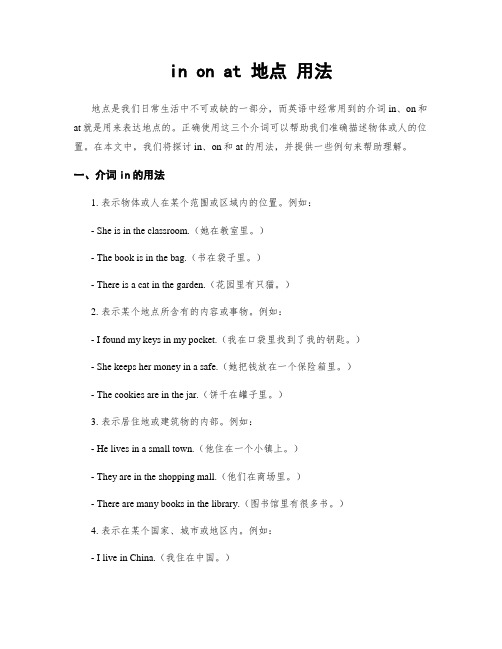
in on at 地点用法地点是我们日常生活中不可或缺的一部分,而英语中经常用到的介词in、on和at就是用来表达地点的。
正确使用这三个介词可以帮助我们准确描述物体或人的位置。
在本文中,我们将探讨in、on和at的用法,并提供一些例句来帮助理解。
一、介词in的用法1. 表示物体或人在某个范围或区域内的位置。
例如:- She is in the classroom.(她在教室里。
)- The book is in the bag.(书在袋子里。
)- There is a cat in the garden.(花园里有只猫。
)2. 表示某个地点所含有的内容或事物。
例如:- I found my keys in my pocket.(我在口袋里找到了我的钥匙。
)- She keeps her money in a safe.(她把钱放在一个保险箱里。
)- The cookies are in the jar.(饼干在罐子里。
)3. 表示居住地或建筑物的内部。
例如:- He lives in a small town.(他住在一个小镇上。
)- They are in the shopping mall.(他们在商场里。
)- There are many books in the library.(图书馆里有很多书。
)4. 表示在某个国家、城市或地区内。
例如:- I live in China.(我住在中国。
)- He is in New York.(他在纽约。
)- They are in the countryside.(他们在乡下。
)5. 表示某个时刻或时间段内。
例如:- We usually have lunch in the afternoon.(我们通常在下午吃午饭。
)- The concert will start in an hour.(音乐会将在一个小时后开始。
)- They will arrive in a few minutes.(他们将在几分钟内到达。
- 1、下载文档前请自行甄别文档内容的完整性,平台不提供额外的编辑、内容补充、找答案等附加服务。
- 2、"仅部分预览"的文档,不可在线预览部分如存在完整性等问题,可反馈申请退款(可完整预览的文档不适用该条件!)。
- 3、如文档侵犯您的权益,请联系客服反馈,我们会尽快为您处理(人工客服工作时间:9:00-18:30)。
by, beside, near和next to 三个词都是"在旁边,在附近,靠近“ 的意思:但是表示远近时候还是 有区别的。从近到一般近到最近为到: near > beside/by> next to
近义词
反义词
by == beside
over —— under
before == in front of
1) under在……下面/正下方. 如: What's under your desk? 2) below 在……斜下方. 如: Her skirt came below her knees.
3:in 和on表示“在……上”
1.门一类——镶嵌在墙里的,用in, 字画一类——挂在墙面上的,用on. 2.鸟一类落在树上的,用in; 苹果一类长在树上的,用on. 4:in /on/ to表示方位 in表示在某范围之内; to表示在某范围之外; on表示“邻”、“接壤”。 Shanghai lies in the east of China. 上海位于中国东部。 Japan lies to the east of China. 日本在中国东部。 Mongolia(蒙古国)lies on the north of China. 蒙古人民共和国位于中国北部。
辨析4: by, beside, near和next to 1) by和beside均表示“在……旁边”,常可换用 例:Come and sit beside (/by) me. 过来,坐在我边上。 2) near表示“在……附近”,表示的距离比by和beside稍 远些。 例:There is a post office near No. 1 Middle School. 第一中学附近有一所邮局。 3) next to表示“紧靠……的旁边”,表示的距离最近。 例:The new building next to the bookstore is a cinema. 书店旁边的那幢新楼是一家电影院。
方位介词 用法总结
1:over, above和on的用法 1)over指在…的正上方,表示垂直在上。 如:There is a lamp over the desk. 2) above指在上方,属于斜上方。 如:Raise your arms above your head. 3) on指在上面,表示两物体接触。 如:There is a cup on the table. 2:under / below的用法:
-Where’s the soccer ball?
-It’s _____ near the box. -Where’s the soccer ball? -It’s ________ next to the box.
-Where’s the soccer ball? -It’s __________ in front of the box. -Where’s the soccer ball? -It’s _________ behind the box.
Where is the snail?
under
in
on
next to
A
B
behind between and in front of
near
across from
-Where’s the soccer ball? -It’s ____ the box.
on the box
in the box
under the box
Байду номын сангаас
Summary
in On Above over below under in front of before behind Between among beside / by near next to 在……里面 在……表面 在……上方 在……正上方 在……下面 在……正下面 在……前面 在……后面 在两者之间 在三者或者三者以上之间 在……旁边 在……附近 紧靠……的旁边
in front of Kitty. Simon sits ____________ between Millie _____ and Simon. Amy sits __________ The chalk is ______ on the teacher’s desk. Amy sits _______________ Sandy. in front of
above —— below
behind == in front of
介词练习:
介词大考验 on Jerry is
the plate.
介词大考验
Look! Jerry is in the bottle.
介词大考验
Jerry
is underthe cheese.
介词大考验
Tom is lying(躺) behind Jerry.
There is a pig across from the bird.
The man is in front of the bus.
The driver is in the front of the bus.
over
over表示垂直在…之上
Where is the duck?
Do you know it?
-Where is the soccer ball? -It’s _________________________________. between the big box and the small box
across from
across from 表示在对面
street / river
in front of me. Millie sits ____________ between Millie ______Simon. and Amy sits _________ Kitty sits _____________ next to/beside Sandy. Sandy sits _________ between Kitty ______ and me. behind Kitty sits ___________ Simon.
above
above,在…之上,不一定垂直
Where is the duck?
Do you know it?
under
under表示垂直并不与表面接触的下方
Where is the duck? Do you know it?
below
below表示非垂直并不与表面接触的下方
Where is the duck? Do you know it?
5:at, in表示“在……” 1)at表示较小的地点。 如: at the bus stop, at home 2)in表示较大的地点。 如: in China, in the world 6:in front of 和in the front of 1) in front of表示“在…之前”(范围外)。 如:There are some trees in front of the classroom. 2) in the front of 表示“在…的前部”(范围内) 如:There is a blackboard in the front of the classroom. 7:through / across通过,穿过 across表示横过,即从物体表面通过,与on有关,为二维 through穿过,即从物体内部穿过,与in有关,为三维。
